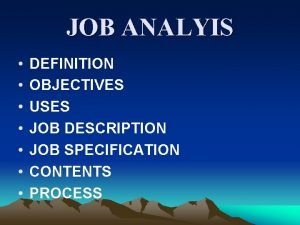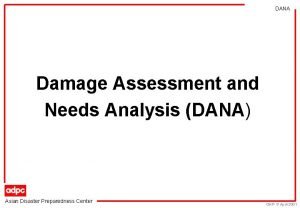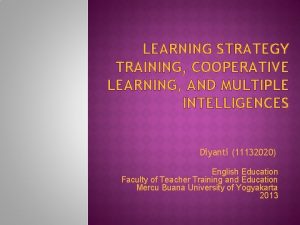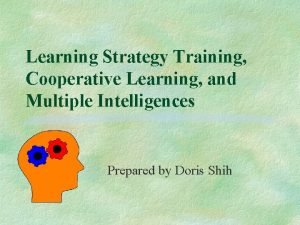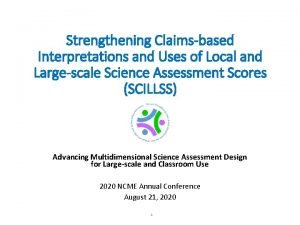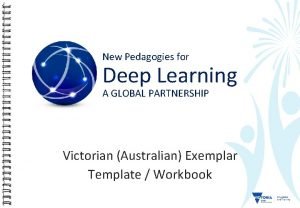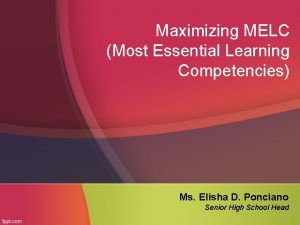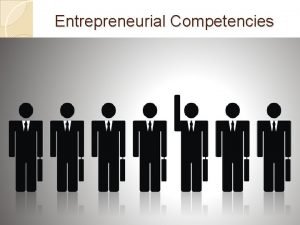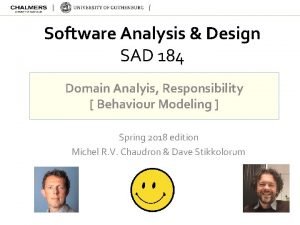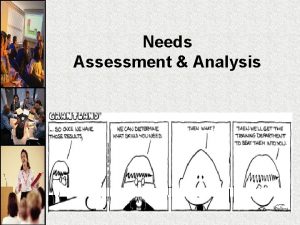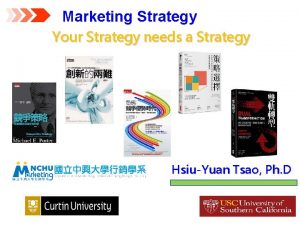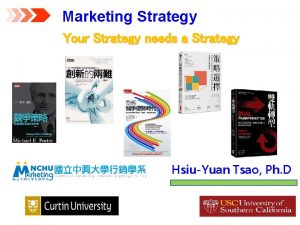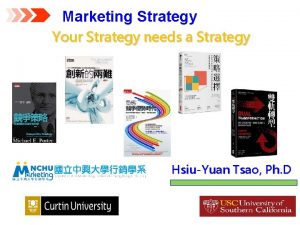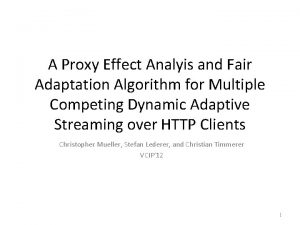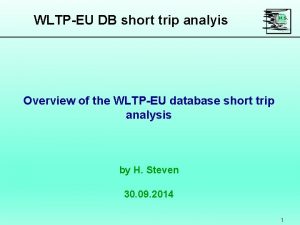LEARNING ASSESSMENT STRATEGY TRAINING NEEDS ANALYIS Analysis Competencies














- Slides: 14

LEARNING & ASSESSMENT STRATEGY TRAINING NEEDS ANALYIS Analysis Competencies/ Knowledge Required External Requirements Organisational Requirements Learning and Assessment Strategy (LAS) Design Develop Implement (Providing a combined strategy for developing the training) Learning Plan Assessment Mapping Training Materials Assessments (Content, Handouts, Aids, etc. ) Implement Course/Training (Course/Package delivery through appropriate methods) Assessments/Feedback Evaluate (Testing, Results Analysis, Quality Assurance) Audit and Validation (Training Package and Assessment Validation)

WHAT IS IN THE LAS? Learning and Assessment Strategy (LAS) (Providing a combined strategy for developing the training) LEARNING STRATEGIES ASSESSMENT STRATEGIES § What do I want them to learn in relation to the Competencies and Knowledge identified in the TNA (e. g. What is important)? § How do I want them to learn the content? § What type of memories do I want to create and then test? § What is the best way to test? § What is important to test? § How do I best align this to the Learning Strategies? Model developed from information at: Walvoord & Anderson (2011); Jaafar, et al. (2008); Herrington (2006); Gardner & Gardner (2012); Schmeck (2013); Moore, Green & Gallis (2009); Heritage (2007); Black & William (2006)

LEARNING STRATEGIES § What do I want them to learn in relation to the Competencies and Knowledge identified in the TNA LEARNING STRATEGIES LAS (e. g. What is important)? Importance Rating § What do#I want them to learn in relation 1 to the Competencies and Background/Collateral Knowledge identified in the TNA A Useful 2 is Useful Ancillary (e. g. What important)? Scale Moderately Important § How do 3 I want them to learn the content? 4 Very Important 5 Absolutely Essential Training Needs Analysis Learning Objective (Competency Required) 4 Required Skills Required Knowledge 4 3 Normally there is a flow down effect Model developed from information at: Walvoord & Anderson (2011); Jaafar, et al. (2008); Herrington (2006); Gardner & Gardner (2012); Schmeck (2013); Moore, Green & Gallis (2009); Heritage (2007); Black & William (2006)

WHAT IS IN THE LAS? Learning and Assessment Strategy (LAS) (Providing a combined strategy for developing the training) LEARNING STRATEGIES ASSESSMENT STRATEGIES § What do I want them to learn in relation to the Competencies and Knowledge identified in the TNA (e. g. What is important)? § How do I want them to learn the content? § What type of memories do I want to create and then test? § What is the best way to test? § What is important to test? § How do I best align this to the Learning Strategies? Model developed from information at: Walvoord & Anderson (2011); Jaafar, et al. (2008); Herrington (2006); Gardner & Gardner (2012); Schmeck (2013); Moore, Green & Gallis (2009); Heritage (2007); Black & William (2006)

SELECTING LEARNING STRATEGIES Still Pictures SIGHT ONLY Diagrams/Charts/Maps etc. Silent Motion Pictures SIGHT AND SOUND Illustrated lectures Videos Directive Demonstrations Passive Single Channel Input stimulating sight only, but using graphical or iconic input Passive Dual Channel Input Audience Inclusive Demonstrations SIMULATED Role Playing (Dramatised Experiences) EXPERIENCE Workshops and Group Design Process with output Active Multi-Channel Experience in simulated situation Direct Experience (e. g. building/operating/doing) LIKELY RETENTION OF INFORMATION (The broader the tier the more information is typically remembered) Active Multi-Channel experience in real situation Web based Learning Web Pages/ e. Learning Gamification Passive Single Channel Input stimulating hearing only Face-to-Face (F 2 F) Lecture/Tutorial/Workshop Recordings SOUND ONLY Radio/Telephone PASSIVE Symbols Passive Single Channel Input that needs to be decoded effectively for storage in Long Term Memory ACTIVE ABSTRACT SYMBOLS Text ACTUAL EXPERIENCE Learning Strategies COMMUNICATIONS CHANNELS Speaker Only CONCRETE Problem Based Learning Case Based Learning/ Discovery Learning Directive Learning/ Situated Learning CONTENT Blended Learning Techniques Model developed from information at: Dale (1969); Mayer & Moreno (1998); Sloan & Latham (1981); Wiman & Mierhenry (1960); Paivo (1991); Cole & Chan (1994); Sintra (1986); Lalley & Miller (2007); Wood (2015); Masters (2013); Kanmani & Babu (2015); Gonzales & Mora (2014); Unger, Schwartz & Foucher (2013)

SELECTING ASSESSMENT STRATEGIES Silent Motion Pictures Illustrated lectures Videos Directive Demonstrations Web based Learning Web Pages/ e. Learning Gamification Still Pictures SIGHT AND SOUND § What type of memories do I want to create and then test? Passive Single Channel Input stimulating hearing only Face-to-Face (F 2 F) Lecture/Tutorial/Workshop Recordings SOUND ONLY Radio/Telephone Speaker Only PASSIVE Symbols ASSESSMENT STRATEGIES Passive Single Channel Input that needs to be decoded effectively for storage in Long Term Memory § What is the best way to test? Passive Single Channel Input stimulating sight only, but using graphical or iconic input § What is important to test? § How do I best align this to the Learning Strategies? Active Multi-Channel Passive Dual Channel Input Audience Inclusive Demonstrations SIMULATED Role Playing (Dramatised Experiences) EXPERIENCE Workshops and Group Design Process with output Experience in simulated situation Direct Experience (e. g. building/operating/doing) LIKELY RETENTION OF INFORMATION (The broader the tier the more information is typically remembered) Active Multi-Channel experience in real situation ACTIVE ABSTRACT SYMBOLS Text ACTUAL EXPERIENCE Learning Strategies COMMUNICATIONS CHANNELS SIGHT ONLY Diagrams/Charts/Maps etc. CONCRETE Problem Based Learning Case Based Learning/ Discovery Learning Directive Learning/ Situated Learning CONTENT Blended Learning Techniques Model developed from information at: Dale (1969); (2005); Mayer Rowland & Moreno&(1998); Sloan & Latham (1981); &Wiman Mierhenry (1960); Paivo (1991); Cole & Chan (1994); Model developed from information Feldman Kentrose (2008); Rose, Haider Buchel&(2010); Squire (1992); Chan & La. Paglia (2013); Sintra (1986); Lalley & Miller. Roediger (2007); Wood (2015); Masters (2013); Kanmani Babu Gonzales & Mora Unger, Schwartz & Foucher (2013) Beaunieux, et al. (2006); & Karpicke (2006); Reber (1989); Brown, &Bull & (2015); Pendlebury (2013); Boud (2014); & Falchikov (2006)

SELECTING ASSESSMENT STRATEGIES (WHAT DO YOU NEED TO TEST? – TYPES OF MEMORY) Do you need them to: Remember Facts (Semantic/Episodic) Apply concepts and ideas to other circumstances Complete actions competently Facts (Declarative/ Explicit Memory) In what year was the first moon landing? Answer: 1969 (24 July) Transfer (Constructing broader Mental Models that are applicable to other situations) Application (Non-Declarative/Implicit/ Procedural Memory) Mathematical problem solving (e. g. volume of a shape) Driving a car Model developed from information at: Feldman (2005); Rowland & Kentrose (2008); Rose, Haider & Buchel (2010); Squire (1992); Chan & La. Paglia (2013); Beaunieux, et al. (2006); Roediger & Karpicke (2006); Reber (1989); Brown, Bull & Pendlebury (2013); Boud & Falchikov (2006)

SELECTING ASSESSMENT STRATEGIES (WHAT IS THE BEST WAY TO TEST DIFFERENT TYPES OF MEMORY) KNOWLEDGE BASED TESTING (KBT) ü Written tests Multiple-choice or ü Online tests Explicit knowledge testing ü Verbal quizzes Facts (Declarative/ Explicit Memory) Transfer (Constructing broader Mental Models that are applicable to other situations) Application (Non-Declarative/Implicit/ Procedural Memory) PRACTICAL WORK ü Groupwork ü Discussions ü Problem solving exercises ü Written essays ü Testing practical application Model developed from information at: Rowland & Kentrose (2008); Rose, Haider & Buchel (2010); Squire (1992); Chan & La. Paglia (2013); Beaunieux, et al. (2006); Roediger & Karpicke (2006); Reber (1989); Brown, Bull & Pendlebury (2013); Boud & Falchikov (2006); Blanch-Hartigan (2011); Young (2013)

SELECTING ASSESSMENT STRATEGIES (WHAT DO YOU NEED TO TEST? ) These are not mutually exclusive Facts (Declarative/ Explicit Memory) Test remembering specific rules Test applying their implications Transfer Application may also require testing of facts & transfer (Constructing broader Mental Models that are applicable to other situations) Application (Non-Declarative/Implicit/ Procedural Memory) Test driving a car Model developed from information at: Race (2014); Keeley (2015); Walvoord & Anderson (2011); Pelegrino & Baxter (1999); Stiggins, et al. (2004); Hillocks (2002); Gijbels, Dochy & Van den Bossche (2005); Shute, Ventura & Bauer (2009); Hargreaves (2005); Andrade, Du & Wang (2008)

SELECTING ASSESSMENT STRATEGIES (WHAT DO YOU NEED TO TEST? – WHAT IS IMPORTANT? ) And you can’t test everything So you have to identify what is important Facts (Declarative/ Explicit Memory) Transfer (Constructing broader Mental Models that are applicable to other situations) Application (Non-Declarative/Implicit/ Procedural Memory) Link to the Useful Scale Test remembering specific # Type of knowledge/skill rules 1 Background/Collateral 2 3 4 5 Test applying Useful Ancillary their Moderately Important implications Very Important Absolutely Essential Test driving a car Model developed from information at: Race (2014); Keeley (2015); Walvoord & Anderson (2011); Pelegrino & Baxter (1999); Stiggins, et al. (2004); Hillocks (2002); Gijbels, Dochy & Van den Bossche (2005); Shute, Ventura & Bauer (2009); Hargreaves (2005); Andrade, Du & Wang (2008)

SELECTING ASSESSMENT STRATEGIES (WHAT DO YOU NEED TO TEST? ) And you need to match Facts Content the assessment against what is Transfer Delivery being taught (Declarative/ Explicit Memory) (Constructing broader Mental Models that are applicable to other situations) Application (Non-Declarative/Implicit/ Procedural Memory) Model developed from information at: Race (2014); Keeley (2015); Walvoord & Anderson (2011); Pelegrino & Baxter (1999); Stiggins, et al. (2004); Hillocks (2002); Gijbels, Dochy & Van den Bossche (2005); Shute, Ventura & Bauer (2009); Hargreaves (2005); Andrade, Du & Wang (2008)

MATCHING DELIVERY TO TESTING Reading e. Learning Text Symbols Facts Lectures/Tutorials/etc. Recordings Text Symbols Recordings Radio/Telephone Speaker Only Still Pictures Diagrams/Charts/Maps etc. Silent Motion Pictures Illustrated lectures Videos Directive Demonstrations (Declarative/ Radio/Telephone Explicit Speaker Only Practical Demonstrations Memory) Still Pictures Direct Experience Diagrams/Charts/Maps etc. Silent Motion Pictures Transfer Illustrated lectures (Constructing broader Practical Demonstrations Videos Mental. Directive Models. Demonstrations that are applicable Direct Experience to other situations) Audience Inclusive Demonstrations Role Playing (Dramatised Experiences) Workshops and Group Design Process with. Workshops output and Group Design Process with output Application (Non-Declarative/Implicit/ Procedural Memory) Direct Experience (e. g. building/operating/doing) Delivery (Learning Strategies) Facts (Declarative/ Explicit Memory) Transfer (Constructing broader Mental Models that are applicable to other situations) Application (Non-Declarative/Implicit/ Procedural Memory) Assessment (Testing Strategies) Model developed from information at: Race (2014); Keeley (2015); Walvoord & Anderson (2011); Pelegrino & Baxter (1999); Stiggins, et al. (2004); Hillocks (2002); Gijbels, Dochy & Van den Bossche (2005); Shute, Ventura & Bauer (2009); Hargreaves (2005); Andrade, Du & Wang (2008)

LEARNING STRATEGY DEVELOPMENT ü You can use any form of LAS ü Here is a fast track form that may help

Copywrite Notice All of the material in this presentation is owned by Seahorses Consulting and Dr. Bruce Hilliard. This material may not be promulgated, copied in any way, or further distributed without the express written permission of Dr. Bruce Hilliard. For further information contact: info@seahorses-consulting. com
 Job description
Job description Analisis strength
Analisis strength Graves 2000
Graves 2000 Dana asian
Dana asian Primary needs and secondary needs
Primary needs and secondary needs Satisfaction
Satisfaction Alpha press murray
Alpha press murray Strategic gender needs and practical gender needs
Strategic gender needs and practical gender needs Learning strategy training
Learning strategy training Learning strategy training
Learning strategy training Unpacking competencies using 5ps
Unpacking competencies using 5ps Process-oriented rubric example
Process-oriented rubric example Deep learning competencies 6 c's
Deep learning competencies 6 c's Kasanayang pampagkatuto mula sa melcs
Kasanayang pampagkatuto mula sa melcs Stages in implementing portfolio assessment
Stages in implementing portfolio assessment
